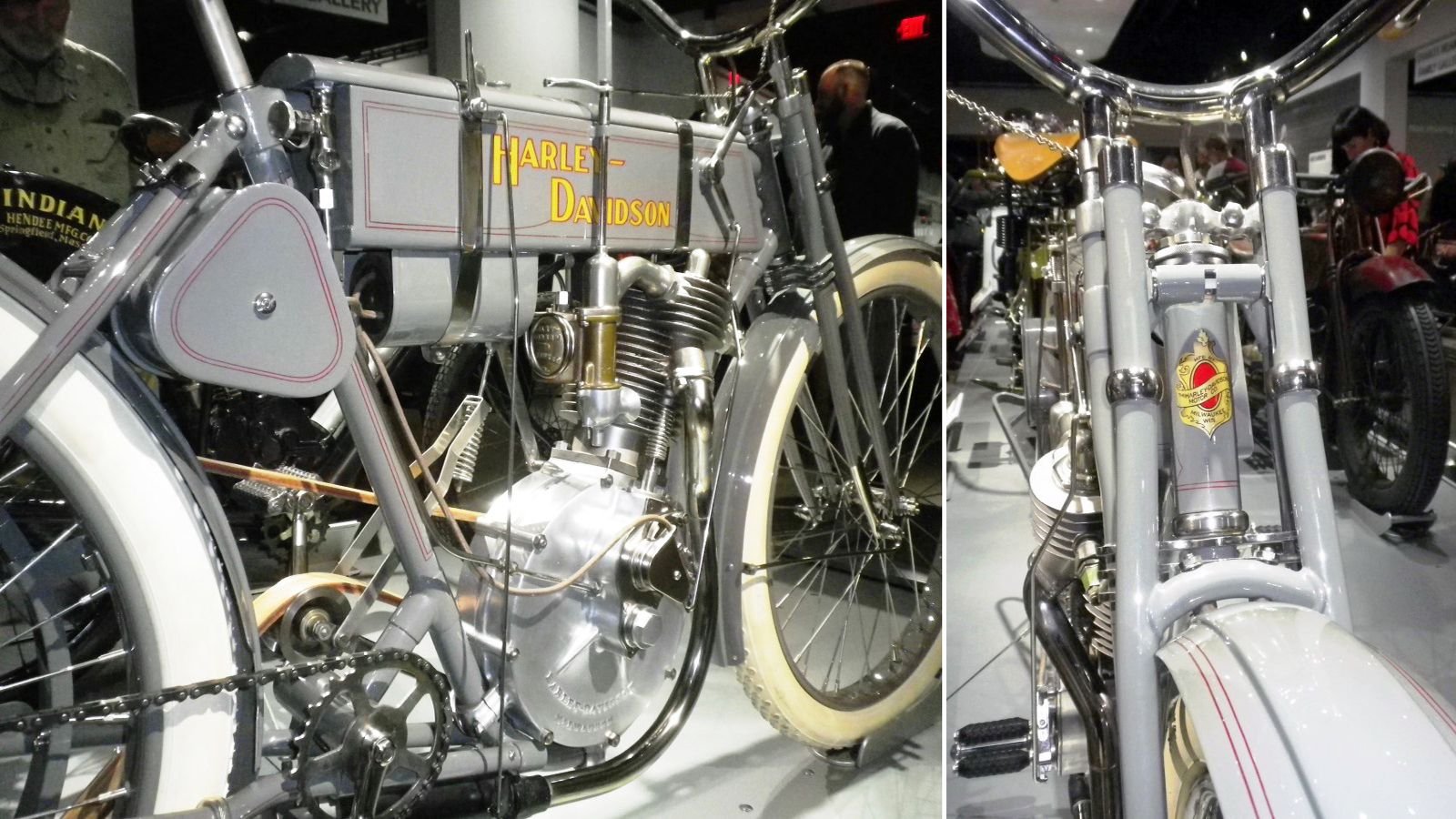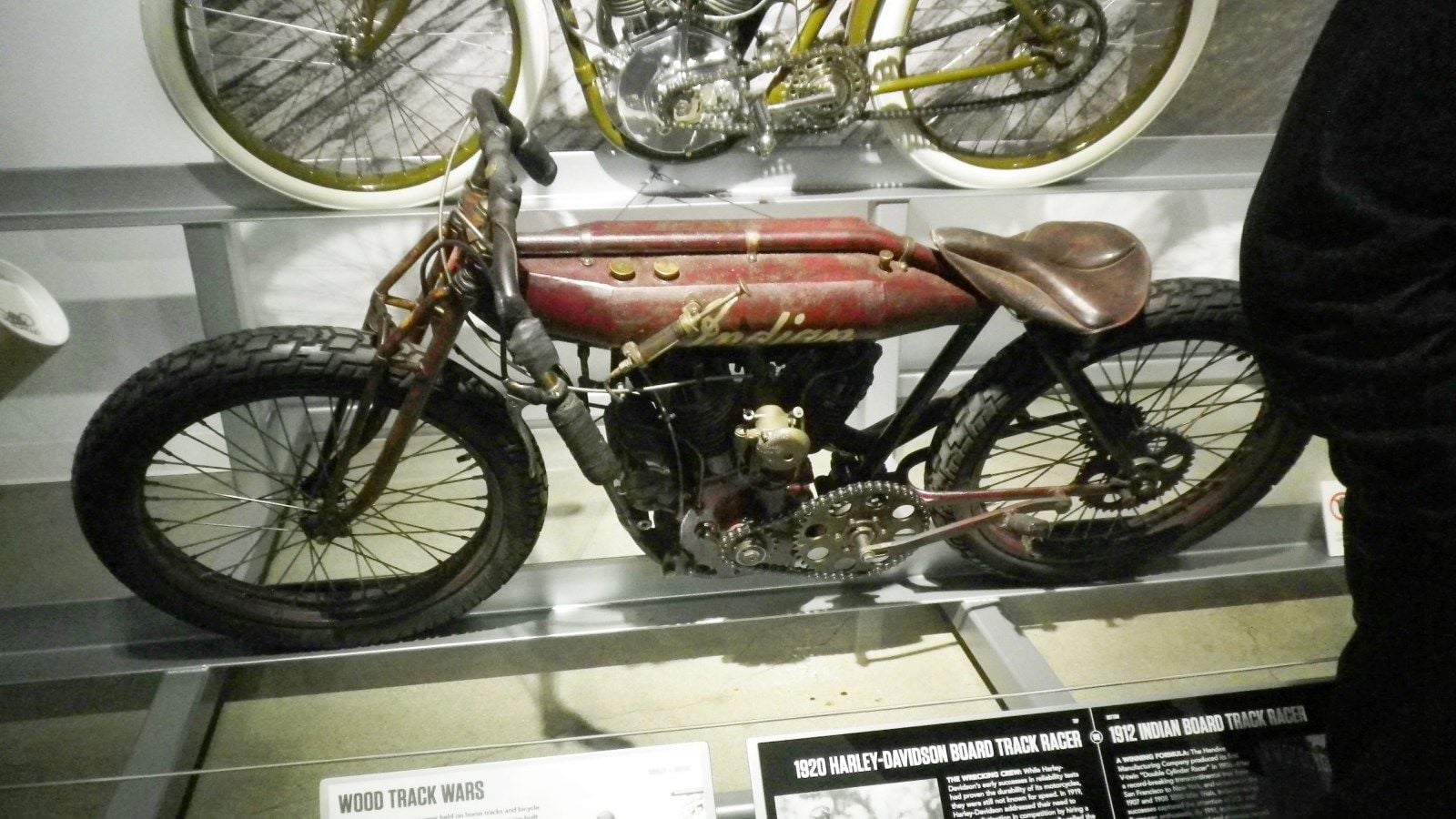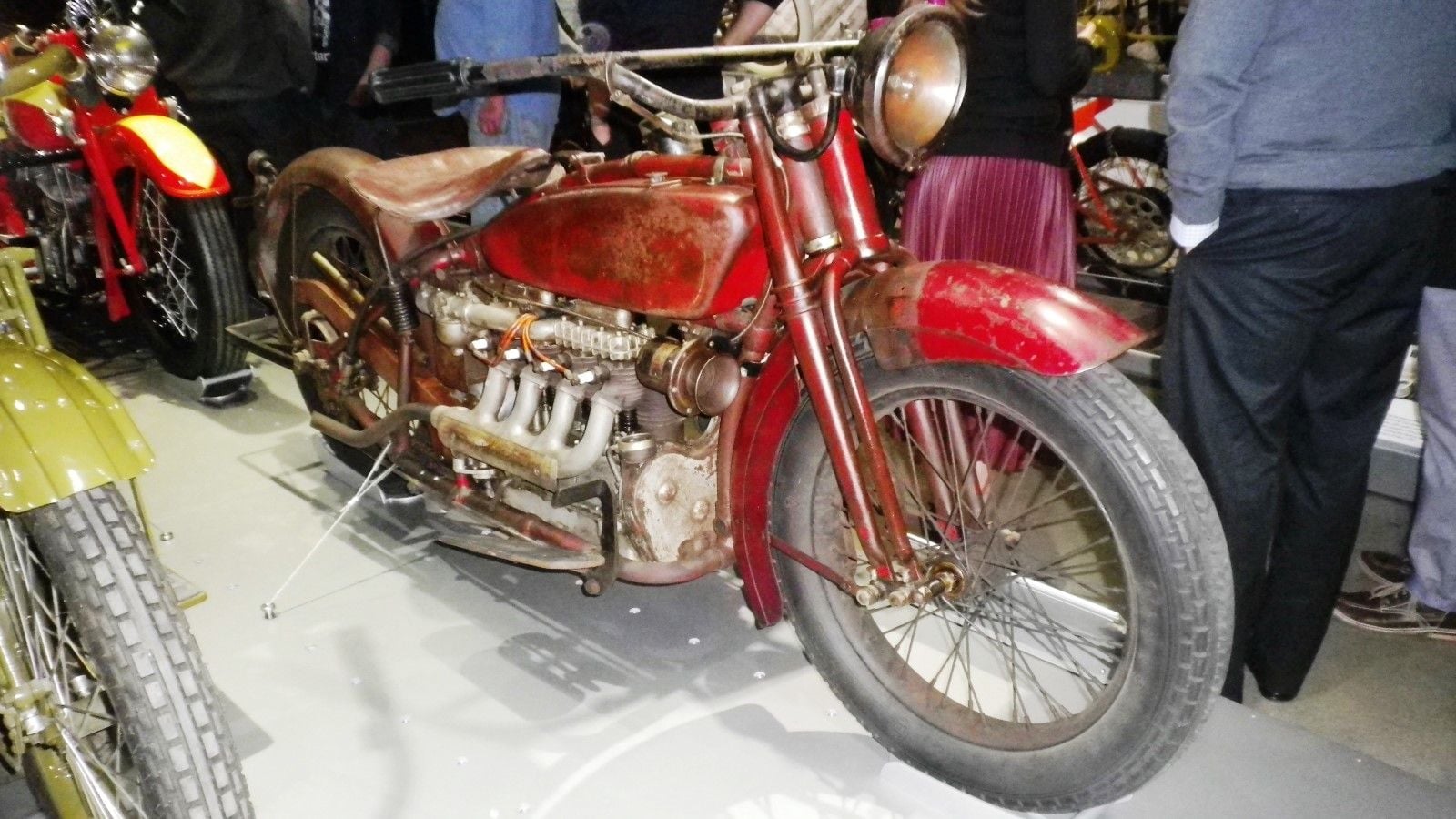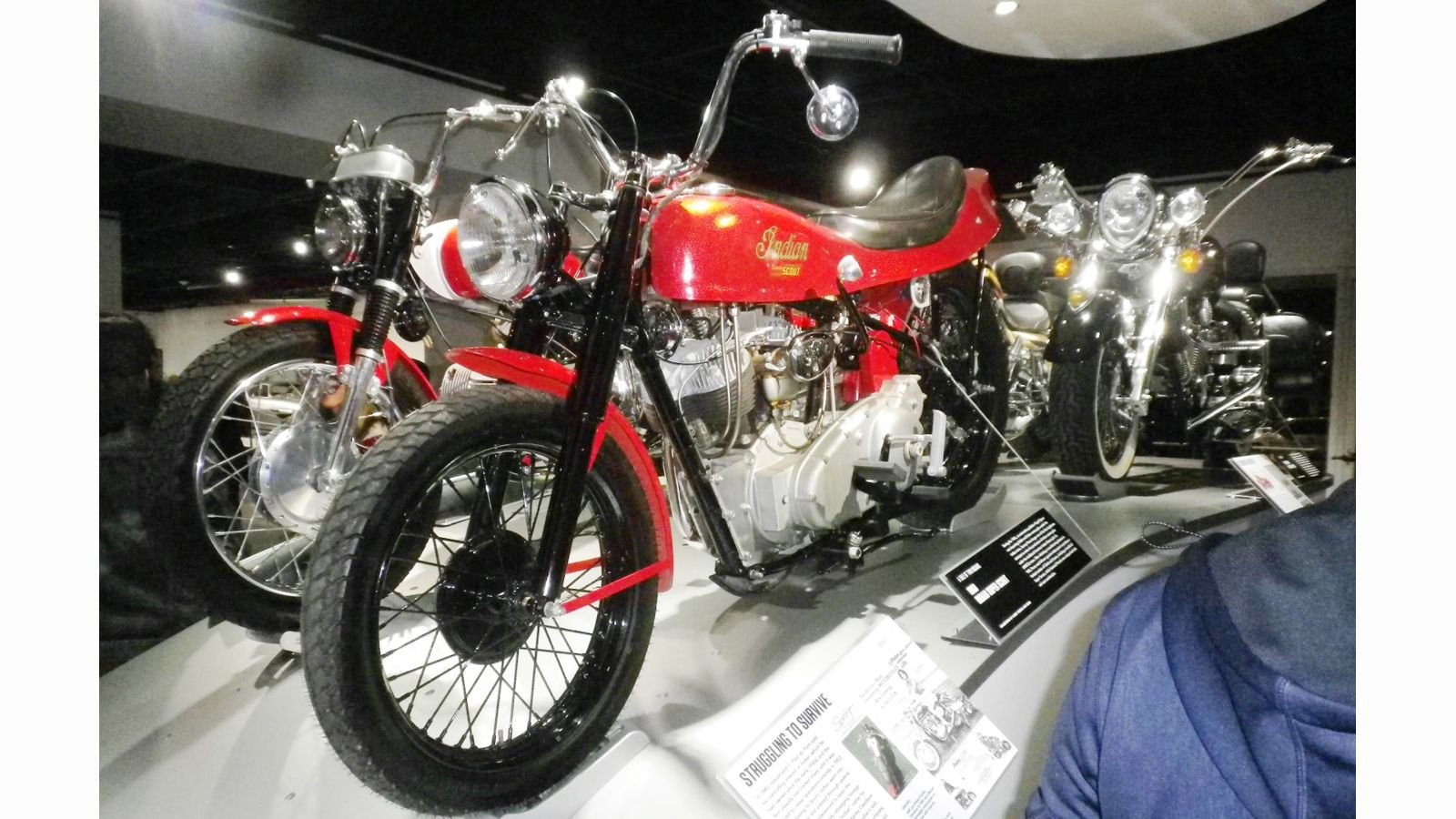10 Great Bikes from Petersen Museum's Harley vs Indian Exhibit
The The Petersen Museum in Los Angeles just launched an exhibit celebrating the rivalry between Harley-Davidson and Indian, which runs until 2018. Here's a bunch of cool bikes from both brands we saw there at the opening party.




















1. 1902 Indian Camelback
The oldest bike in the exhibit is this 1902 Indian motorized bicycle, nicknamed the camelback because of the curved fuel tank mounted on the rear fender. By the time they made these first motorcycles they had already been in business for 3 years making Indian bicycles. This may be the most primitive of the bikes on display, but you can't deny wanting to hop on it and ride it down to the corner store, belching smoke and fire the whole way.
2. 1908 Harley-Davidson Model 4 Strap Tank
Officially this silent grey and polished nickle machine is a Model 4, but folks usually refer to them as the strap tank model, because of the way the tank is hung from the top tube of the frame. This bike sits next to the camelback Indian, and it is amazing how far motorcycles had come in just those 6 years. That slack chain from the handlebar to the tank appears to be the control for the throttle, though many machines of this era used an all or nothing system with a kill switch and belt tensioner.
3. 1920 Indian Daytona Racer with Flxicar
These early bikes are a huge draw for gearheads who like to geek out on how machines work because everything is right out in the open in front of your eyes. This bike, equipped with the Powerplus V-twin motor, was designed with a sidecar that stays still while the bike, rider and 3rd wheel lean into corners. Having a passenger in the car gave the bike better traction for the big high-speed corners on the beach course at Daytona. Engineering it to lean meant it handled like a motorcycle with an extra wheel and not like a car that was missing one.
4. 1920 Harley-Davidson Board Tracker
Seeing the board track racers in Los Angeles is great, since there were probably a dozen board tracks within 10 miles of the museum location back in the day. This V-twin racer was from the original Harley-Davidson "Wrecking Crew" era, when the large team of factory rider dominated nationwide, winning every single nation event in 1922. These bikes not only lacked brakes, but often had only a kill switch to control speed, and no throttle.
5. 1912 Indian Board Tracker
Right next to the HD board track racer was this earlier Indian racer, which is similar to the ones that finished 1st, 2nd and 3rd at the Isle of Man road race in 1911. One of the great things about this exhibit is that some of these bikes, such as this one, are not over restored pieces of jewelry. This Indian is still in very much as raced condition, with few updates to it besides the obvious modern tires. Hopefully, the owner of this priceless Indian leaves it in this condition so he can occasionally ride it around without worrying about it getting scratched.
6. 1921 Harley-Davidson Model W Sport Twin
This detail shot shows exactly how much engineers didn't know about internal combustion motors at the time. The Model W Sport Twin, introduced in 1919, featured modern innovations like automatic oiling, and an integral clutch and transmission. However, it also featured a cast iron intake/exhaust manifold which must have heated the intake air to 600 degrees between the carburetor and the cylinders. Bad design or not, these bikes are still great to look at.
7. 1927 Indian Ace Four
Another amazingly intact, unrestored, Indian is this four cylinder Ace. From 1927 to 1942 Indian made these advanced, air cooled 4 cylinder bikes, based on the design they bought from the Ace Motor Corp. No exhibit or discussion of early motorcycles can be complete without at least a mention of the Indian Four.
8. Indian and Harley-Davidson Mini Bikes and Scooters
Much later in life, after WWII, both companies began to experiment with appealing to younger riders. Seen here are the Harley X-90 and Indian Mini Mini Bambino (this from the Indian's strange middle age) mini bikes, and the 1963 Harley Topper and 1948 Indian Stylemaster. None of these bikes were particularly successful, though during the AMF years Harley did manage to sell plenty of dirt bikes of all sizes.
9. 1939 Indian Sport Scout
Some people love the big, fat, full-fendered Indian touring bikes, but the stripped down bikes like this Sport Scout are much more to my taste. While Indian had been the innovator originally, by this point Harley had introduced the OHV knucklehead (one is sitting right next to the Scout) while Indian persisted with the flathead. It isn't hard to see that even before WWII Indian was not int eh best of shape.
10. 1968 Indian "Super" Scout
Almost from the day Indian shut the Springfield factory in 1953, various people have been trying to bring it back from the dead, though Polaris seems to have finally succeeded. The Polaris Indians share nothing but a name and style with the old Springfield Indians, though there is a company (Kiwi Indian) still cranking out those. In much the same way, back in the 1960s Floyd Clymer (with the legal rights to the name) making new bikes called Indians which were mostly European bikes rebranded, while Sammy Pierce was building a continuation of the old bikes with reproduction parts. The bike pictured was the top of the line of Sammy's Indians, with a one piece Triumph X75 type one piece seat/tank.
You can read more about the exhibit and The Petersen Museum at their website.
If you have service or maintenance questions, the how-to section of HDForums.com has answers.

